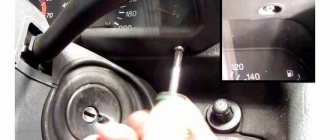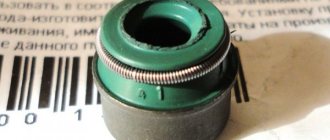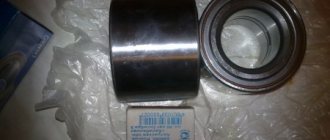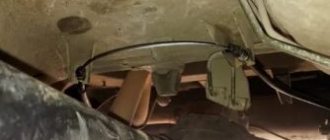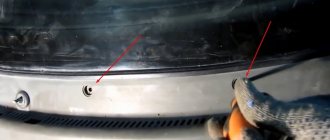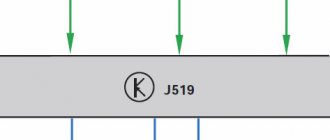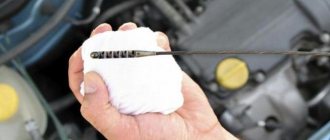The most important organ in any car is the brake system. It must be in perfect condition, because our lives depend on it. One of the main indicators of the efficiency of this unit is the pedal, which must always differ in the state of pressing that is familiar to the foot. This rule cannot be neglected and if the slightest changes occur, adjustments or repairs must be made immediately. Below we will look at what needs to be done when the brake pedal becomes hard, does not press at all, or grabs at the very end of its stroke. We will also pay attention to the issues of self-diagnosis and study all the reasons for the failure of this mechanism.
The brake system fault indicator is on
Most often, the reason is trivial - like a low level of brake fluid in the reservoir or excessive wear of the brake pads equipped with the corresponding sensors. Another simple reason could be... the parking brake is on (it happens that the limit switch is simply faulty). However, brake fluid leaks can also be the cause of a decrease in the level - they must be urgently identified and eliminated.
Brake failure on cars with automatic transmission. What to do - tips
We are all taught in driving schools what to do if the brakes fail. This usually happens during practical training with an instructor.
If the instructor is really interested not only in making money, but also in producing a full-fledged future driver, then he will definitely show you and tell you all the tricks for such a situation.
One problem: this is usually taught when driving a manual transmission; with an automatic transmission everything is a little different! Today we will look at methods of braking when the brakes fail on an automatic transmission.
So, brake failure on a car with automatic transmission. What to do - tips
.
1) Stop panicking
Yes, “everything is clear”, etc., the most important advice is always. They have this in common with “mechanics”. But this is really important!
We are trying to act calmer, even though it is difficult. If the brakes still fail, we immediately turn on the “cold” mind, and at the same time turn on the emergency lights. Go ahead!
2) “Pumping” the brakes
The very first thing is to take your foot off the gas pedal. Then quickly, firmly and repeatedly press the brake pedal to the floor. A car has more than one brake circuit. There is a possibility that one of them will work temporarily at this moment.
This will especially help if you have an “electric” handbrake. At high speeds, the system simply will not allow you to use the handbrake.
Parking brake ineffective
Have you tightened the lever, but the car still tries to roll downhill? In the simplest cases, the parking brake just needs to be adjusted normally. In addition, oiliness of the brake pads can affect it. It happens that the cables are jammed in the sheaths. Possible causes include oily discs or drums. Completely worn out pads may be to blame. And if the parking brake does not release the car, then most likely the pads are frozen or rusted to the brake drums.
Automatic engine starting safety
If the gearbox is in parking mode, the electronics block the vehicle from rolling back and spontaneously moving forward. In such a case, the stopper is activated, which completely immobilizes the machine. To remove such a blocker, you need to lightly press the gas pedal, after which the pads will be released and the car will begin to accelerate. On most cars with an automatic transmission, the classic parking brakes no longer exist; the functions of the handbrake are performed by electronics, which does not allow the car to roll away or spontaneously move forward.
Why do many automakers still recommend depressing the brake pedal when starting the engine? This is largely due to the maximum attention to safety. Many car manufacturers believe that, theoretically, an electronic lock during parking may not hold a car that starts moving, thereby creating the danger of a traffic accident. .
Whereas in reality, on most cars, electronics ensure complete safety of vehicle operation, excluding its rollback or spontaneous forward movement.
In each specific case, the method of starting the engine on modern cars with an automatic transmission may differ. In some cars, for example in the cars of the big German three, it will be impossible to start the engine without depressing the brake pedal. This is believed to provide greater security, but this has not been confirmed in any tests.
Let's sum it up
Modern cars with automatic transmissions use an electronic parking brake, and the automatic transmission immediately after turning off the engine activates the Parking mode, which completely prevents subsequent movement of the car when the engine is started. Only on certain brands does the automatic system not allow you to start the engine if the car owner does not press the brake pedal. This is indicated in the instructions for the car, which you need to read before you start using the car.
The algorithm for starting an automatic engine may differ slightly. You only need to press the brake if the car’s automation is configured in such a way that you can start it only by pressing the appropriate pedal.
Source
Brake overheating
This type of malfunction is usually identified by the appearance of a burning smell. This is usually accompanied by an increased pedal travel, which begins to feel weak, as well as an increased braking distance. The cause of overheating can be either excessively active driving with constant braking, or simple forgetfulness, that is, the parking brake is too tight.
Additionally, possible culprits include seized cylinders and calipers.
Diagnostics – what does it include?
If the problem is not yet too obvious: something seems to be wrong, but the braking function is working, you can start with self-diagnosis. Very often, failure occurs due to the fact that insufficient pressure is applied to the pads and discs. This may be due to interruptions in the supply of brake fluid. Start the engine, press the pedals and listen - extraneous sounds are the most obvious sign.
The most important thing is not only to notice in time that the brake pedal has failed. The second important aspect is conducting competent diagnostics. I advise you to contact only proven service stations and not skimp on full diagnostics.
Remember how much time has passed since the brake began to noticeably go down, the last time the fluid was changed. Perhaps it is no longer enough - try adding more. If this does not help, you will have to find out at the service station why the brake pedal failed. Otherwise, such a brake may simply fail at one moment. A quality diagnostic will include a full check of the entire brake system. Particular attention should be paid to the master brake cylinder - if the problem is there, alas, replacement will be required. A good technician will also check the tightness of the pumps, the pressure in the system, the condition of the discs and pads. High-quality diagnostics will take at least 5-6 hours and will cost money: but whatever, the braking system in the car must be at its best.
Noise when braking
High-frequency noise, squealing, and whistling can occur both during braking and, sometimes, during normal movement. The reason is the off-design mode of friction of the friction material on the working surface of the brake disc. Extreme wear on the brake pads and severe corrosion of the brake disc (often on the inside, “invisible” side) may be to blame. It happens that the brake pad lining has peeled off from the base. The list of possible causes continues with contamination of the pads, warping of the disc due to local overheating, improper fastening of the pads in the caliper, left pads or discs, etc.
Vacuum booster - symptoms of malfunction
Almost all cars have a vacuum booster. It reduces the force applied by the driver to the pedal, while at the same time increasing the force transmitted by the fluid. It only works after the engine is started. Poor performance is often caused by wear or damage to the vacuum seal diaphragm. In this case, no vacuum is created in the chamber. We need to look at the fuel fluid level: if it is normal, we check the operation of the amplifier. If the vacuum tank is not topped up in a timely manner, it first malfunctions, then the diaphragm is damaged.
First, we check with the engine not running: depress the pedal and hold it pressed. If it begins to gradually fail, the reason is in the gas turbine engine: the cuffs are leaking or the working surface of the cylinder is worn out. Without releasing the pedal, we start the engine. It should fall smoothly and slightly and stop. If everything is exactly like this, then the vacuum seal is in order. If the pedal falls while the engine is running, the reason is in the amplifier, the GTZ is to blame. When driving with a damaged diaphragm, the speed during braking practically does not decrease. You need to immediately replace the diaphragm with a new one.
When the vacuum seal dies, when braking, the car, especially in cold weather, tends to stall, and the noise of escaping air is clearly audible.
When the brake pedal is released, one of the wheels slows down
The following reasons are suspected: jamming of the wheel cylinder piston, swelling of the brake cups, deformation of the brake pipe, jamming of the pads due to contamination of the guide, peeling of the brake pad lining of the drum brake. It happens that the tension spring of the drum brake shoes is weakened or broken, the parking brake is overtightened, or the cable is stuck in the sheath.
- Do you know which faults you can drive with and which ones you cannot? Take the test and check your driving skill level.
- To increase the life of your car, use additives from SUPROTEC. Original SUPROTEC products can be purchased at.
Why does the brake pedal become hard?
The reason may lie in the vacuum brake booster (VBS), a device that uses rarefied air to increase the efficiency of pressing the pedal. There are several possible problems here:
- limit switch malfunction;
- check valve failure;
- contamination of the air purifying filter;
- fuel entering the VUT chamber;
- diaphragm damage;
- wear and deformation of the hose that is used to connect the VUT and the intake manifold;
- loosening of the hose in the area of the fitting.
Another reason why the pedal becomes hard is the use of low-quality brake fluid. Many people believe that its properties do not change due to movement in a confined space, but this is not so. When a person presses the pedal, air enters the compensation holes along with the moisture contained in it. Over time, the boiling point increases, and the viscosity at low temperatures increases. Using brake fluid that has become unusable can lead to corrosion of internal parts, the formation of vapor locks, and slow vehicle response when the pedal is pressed.
Sometimes the malfunction occurs due to the cylinders. For example, when foreign liquids enter and the sealing rings swell.
Self-diagnosis
If the brake system is depressurized, air masses enter the intake manifold and engine operation becomes unstable. In such cases, car enthusiasts say that the engine is “troubling” (one of the cylinders fails, and the remaining ones work for it). This is accompanied by strong vibrations, a noticeable loss of power, misfires and popping noises in the exhaust system. Another sign that the VUT has failed is a hissing sound that occurs when you press the pedal.
If the problem lies in the amplifier, the breakdown needs to be specified, and this can be done in different ways. One of them is to turn off the engine, wait a couple of minutes and press the pedal. If it remains hard, then the check valve has failed. If the pedal becomes hard after a long period of inactivity or several presses, the problem should be looked for in the amplifier diaphragm.
Another method for diagnosing VUT is also possible. The first thing to do is press the pedal several times without starting the engine. After this, you should hold the brake and turn the ignition key. If the pedal begins to move down smoothly, it means the amplifier is working.
